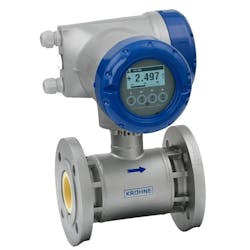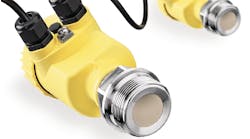Magnetic Precision: Flow Measurement Without Moving Parts
Electromagnetic flow meters are volumetric flow meters that use electromagnetic induction to measure liquid velocity. This measurement method is highly accurate at measuring water-based fluids as they pass through a pipe. They are cost-effective, long-lasting and compatible with existing technology. However, there are things to consider before investing in this technology.
Chemical Processing chatted with Joseph Incontri, director of marketing North America at KROHNE, to help us understand the pros and cons. This is an edited version of that conversation.
Q: How long have electromagnetic flow meters been around?
A: Officially, they're electromagnetic flow meters, but most people call them magmeters, which have been around since the early 50s. KROHNE developed and introduced what we believe to be the first industrial version of a magmeter back in 1952. At the time, they used alternating current as the basis for the measurement, and since then, they've evolved. In the early 70s, they migrated from using alternating current as the basis for the measurement to direct current.
Fundamentally, the technology uses electricity and voltage to create an electromagnet wrapped around a pipe. So, inside the housing of the flow meter, there are two coils, one on the top and one on the bottom, and we're powering those coils with electricity, creating an electromagnetic field. That electromagnetic field alternates so it creates the north pole of the magnet on the top and the south pole on the bottom, and then reversing it at the alternate point, which will induce a voltage in the fluid, making them very popular in water-based measurements because you need a conductive fluid.
That voltage is directly proportional to the velocity of the fluid going through the pipe, so if you have a pipe of a known area and the velocity at which the fluid is flowing through that pipe, you simply multiply the velocity by the cross-sectional area, and now you have a volumetric flow. There are no moving parts, and there's no obstruction in the pipe that would block the flow stream.
Q: What considerations need to be made before using this type of technology?
A: In the chemical industry, these meters find a home in many applications because they can operate at a very low conductivity down to one microsiemens, which is extremely low. They can also work in circumstances where you have high solids content, as well. So, up to 70% solids content is not an issue for these devices.
The other consideration is installation. Is there a certain orientation you must be mindful of? For magmeters, the physical orientation doesn’t matter. It can be vertical, horizontal or anything in between as long as the pipe is full. If you have a less-than-full pipe, you're going to have a natural error in terms of your volumetric flow measurement.
The other thing might be the flow profile. In other words, if you have higher velocity in the center of the pipe as opposed to the sides of the pipe, if you have a very viscous product or something like that, you'll get a bullet-nose type flow profile going through the meter. The electrodes being in the center of the pipe, they'll measure the velocity of the fluid at that center point. You have to account for that flow profile.
Also, an imbalanced flow profile is a consideration. If you're coming off of an elbow and pushing the flow up at the top half of the pipe or at the bottom half of the pipe, you'll have an imbalanced flow profile, which will result in a natural velocity error. You want to have three pipe diameters upstream and at least one pipe diameter downstream of the meter to try to balance out that flow profile so that the velocity measurement being made is reflective of the average velocities in the pipe.
Q: How does it mesh with existing control systems?
A: Magmeters translate an analog signal coming out of the sensor into whatever kind of output a user might require for their control system.
But as you might expect, there are many digital protocols out there, and electronics are adapting to those requirements. Fundamentally, it'll provide whatever you're looking for.
I shouldn't overlook pointing out that there is an opportunity for taking advantage of additional signals coming out of the meter. Secondary signals through digital protocols like HART, for example, enable you to monitor things like coil temperature. The user can take advantage of it and make an inference about what the process temperature might be, or if there's any dramatic change in the coil temperature, it might be an indication that there's something physically wrong with the instrument or it might be an indication that something is changing within the process.
The other thing that a magmeter does is give you a good indication of any changes in conductivity in the fluid. Again, it's not super precise, but it might be a secondary piece of information for a user to monitor what's happening inside the process. So, if you're expecting that you're flowing water, but suddenly you see a change in your conductivity, that might indicate that there might be something going on with the process that you didn't expect.
Q: What about energy efficiency?
A: There have been many developments in terms of energy use. I mentioned that we transitioned from the earliest developments, which used AC power as alternating current applied to the coils, which used a lot of energy and created some drift because you're magnetizing the coils. But now, with DC pulsed, it's a much lower energy signal, so you leave no mark on the coils. You don't create any drift, and it resets every time it alternates the pulse value from a positive to a negative pulse. And so that rebalances the signal and it reduces the energy usage dramatically as compared to the old AC versions.
Q: What about size and design?
A: In terms of diameters, they range from 1/10 of an inch diameter for chemical feeds or up to 120 inches for very large water or wastewater volumes.
Additionally, magmeters come in various designs — flanged or wafer types. You can have them with hard rubber liners for water applications where you don't have to worry about corrosive situations. But you might also want to have something like a PTFE or a Teflon-lined meter or a ceramic-lined meter for applications where you're worried about corrosive chemicals.
And then take it a step further and you can pick all sorts of electrode materials to be in contact with the fluid. The most popular is stainless steel because it's a low cost for standard applications, but you can have Hastelloy C, platinum electrodes, titanium, tantalum electrodes, and for the ceramic meters where you're worried about anything coming out of the meter, you can have electrodless meters where the ceramic is tinged with platinum in the ceramic itself so there's no exposed metal in the flow stream.
Q: How prevalent are magmeters in the industry?
A: In the chemical industry you will find these all over the place. If the fluid is conductive, you'll find a magmeter is suitable. The chemical industry likes it because they're solid state, so the maintenance is reduced. They're loaded with diagnostics as well, so you can be made aware of any metering issues well before there's any catastrophic failure — you can also use that information to monitor your process quite effectively.
You can also verify that the instrument is still operating within its original operating specifications, which is crucial because a lot of processes require very good flow measurement to make sure that you're blending the products at the proper proportions inside the pipe. So, blending applications, feed applications into process vessels, or even filling vessels for transportation when you want to put the products in a tank for delivery somewhere else, are the kinds of applications where you'll find magmeters.
Q: What's the life expectancy?
A: It depends on the rigor of the application you're installed in, but decades is not unusual. If you do a good job selecting the meter, you shouldn't worry about the meters for decades in many instances.
There are exceptions. If you have a lot of pulsating flow that might cause damage to the liner, or if you have unusual circumstances where your flow stream content changes and impacts the liner materials or if you have a lot of erosion that might cause the electrodes to wear out.
Q: What are the disadvantages of magmeters?
A: We discussed the need for conductive fluid. If you don't have conductive fluid, you should consider other technologies. The good news is that KROHNE has Coriolis meters, ultrasonic meters and vortex meters, among other technologies.
The other is that you do need three upstream and one or two downstream from the meter, to make sure that you have a balanced flow profile going through the instrument. So, if you don't have that kind of space, then consider other technologies like a Coriolis meter, which requires no upstream, downstream, or even a variable area flow meter from that standpoint. Most other volumetric flow meter technologies do require upstream, downstream because they all suffer the same consequences if you don't have a balanced low stream.
A magmeter also requires power. It’s a four-wire device, so if you do not have or would rather not have one in the field, you should look at alternate technologies as well.
The other part that we talked about is the meter must be full to measure accurately. So, if you have a less-than-full pipe or the risk of a less-than-full pipe, you probably want to install the meter in a vertical pipe so the meter's always full.
Another consideration is that, in most cases, you should ground the fluid because it is a conductive fluid. What'll happen is you'll have electrical noise that gets carried down the pipe with the fluid, so before that electrical conductor is carrying that noise into the electrode circuit, you want to ground the fluid so that as much of that electrical noise gets nullified and that the electrode is picking up the actual velocity signal alone. So, that is perhaps a disadvantage because if you're dealing with corrosive or exotic fluids, you might need special materials for those grounding rings.
Basically, you ground the fluid by putting metal rings between the flanges of the meter and the pipe. This allows the fluid's electrical potential to be drawn down to the ground. However, there is a potential for leak paths around those grounding rings.
KROHNE has developed something unique called virtual reference. In one of the converters, you can have the option of doing away with grounding rings and using an electrical circuit within the converters.
Q: Are there other newer developments?
A: In terms of the technology, the sensors themselves have not evolved a whole lot since the early 2000s, but the power of microprocessors has become prevalent.
Lately, the range of diagnostics in the instruments has greatly grown, so now you have all sorts of benefits gained from more finite or more precise diagnostics that can help you discern what is going on with the meter itself or what is going on with your process.
But one of the key things that our customers appreciate is the verification of the instruments in the field. With meter verification technology, you can do just about everything to verify the performance and validate that the instrument is still operating within its original specifications. That's really where the most recent advancements have happened.
Q: Let's talk a little bit about sustainability and resource management. How can magmeters impact that?
A: We have talked about the longevity of the instrument. From a sustainability standpoint, that's a key element where you don't have to worry about replacing these meters anytime soon. Yes, they're a little more expensive than some technologies out there. On the other hand, they are extremely reliable and precise, so they help you manage your resources very well and reduce your maintenance load in terms of parts and oversight that you have to provide to the instruments themselves.
Also, with advances in the microprocessor technologies we've talked about, you're using less power than you did in the past for these, so you're also reducing the power load requirements.
Q: Is there anything you want to add?
A: While they've been around forever and people take them for granted, if you are faced with a tough metering challenge and you're considering high-end devices — and by that, I mean your gaze turns to Coriolis meters, which are the most expensive technologies out there — I would encourage you to give electromagnetic flow meters or magmeters another glance. They can do exactly what you need at the performance levels you're looking for at a reasonable price point and certainly at a high availability.
For more information, visit: https://us.krohne.com/





